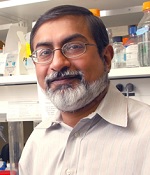 |
| UTSW's Amyn Habib |
For some years now investigators have been studying the role of epidermal growth factor receptor (EGFR) amplification in glioblastomas, a particularly lethal type of brain cancer. But some EGFR inhibitors have not had the success in the clinic that many had expected and glioblastomas in particular have presented a tough target for developers.
A team of neurologists at UT Southwestern notes that EGFR is activated when epidermal growth factor (EGF) binds to it, promoting tumor growth and damping down its response to chemo. And they believe they may have found a particular pathway during their research that could prove attractive for developers involved in oncology.
"Abnormal EGFR signaling, a common and key feature of human cancer, is of considerable interest both for a role in the growth of malignant cells and as a target for treatment," said Dr. Amyn A. Habib, an associate professor of neurology and neurotherapeutics at UT Southwestern and a member of the Harold C Simmons Cancer Center.
Habib and his colleagues zeroed in on a signaling mechanism involved with EGF that may work as a therapeutic target. EGF can trigger what they call "noncanonical" signaling while turning ligand-activated signaling off. As noncanonical EGFR signaling may activate the IRF3 transcription factor, which appears to protect cancer cells, blocking IRF3 may present an attractive target for the right small molecule.
"The noncanonical EGFR signaling network may be an important target for treatment in those cancers in which the level of EGFR ligand is low," Habib said.
The research appears in Nature Communications and was supported by the National Institutes of Health, Department of Veterans Affairs, the William and Sylvia Zale Foundation and the Ethel Silvergold Philanthropic Fund of the Dallas Jewish Community Foundation, and by donations from Barbara F. Glick.
- here's the release
- get the research abstract